- Joined
- Jan 10, 2014
- Messages
- 200
So I made my first chips with the 1236. Wow..I really put my foot in it, didn't I? This was the first time I have machined anything, and I'm afraid I'm hooked.
My first attempt wasn't the best but it was a start:
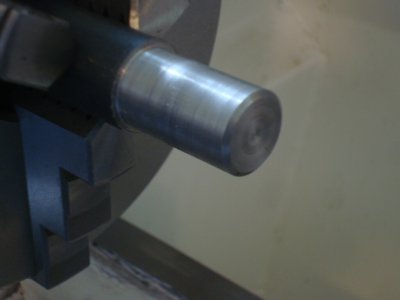
I came back inside, read a few things, changed speeds, and used a tool with a bit of a radius and did this:
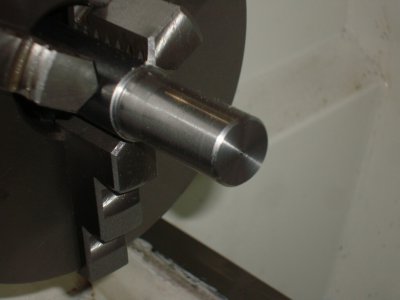
Definitely better. I have some stainless bars that I scrounged, so I decided to give it a try to see whats what:
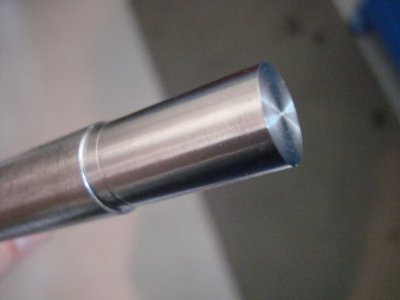
That one came out pretty nice! I must have gotten lucky :thinking:.
I have to say, watching that chip come off that stainless and across the face of the tool like a little stream of water was pretty cool.
I have a few questions about the setting up of this thing, I wanted to run past yall.
I have an actual project that I want to do, so I decided quit just playing around and set this thing up the way it is supposed to be to make it accurate. I have read a bunch of the leveling threads, and plan on doing the 2 collar method.
First, I decided to try to get as much twist out of the bed as I could with my level. I am guessing that this is the right way to set this up. I do understand why it does not need to be Earth level, but I am going by that as an easy to see standard.
I used a Starrett 98-8 level, 2 parallels (checked with a micrometer to make sure they were accurate), and used the flats of the ways. I cleaned all surfaces with napthalene, and when I changed to the tail end of the bed, I put the parallels in the same position relative to each other that I had used at the headstock end. Also, I made sure the parallels only sat on the ground surfaces of the ways. I seem to remember reading that the machinist levels have a slight bow in them, hence they way I placed it on the parallels. Here is what I did:
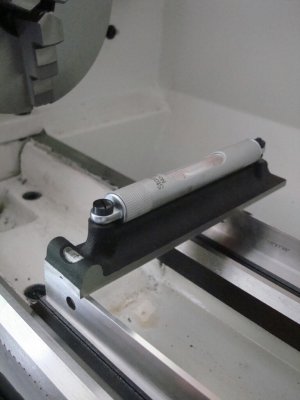
and this was the reading:
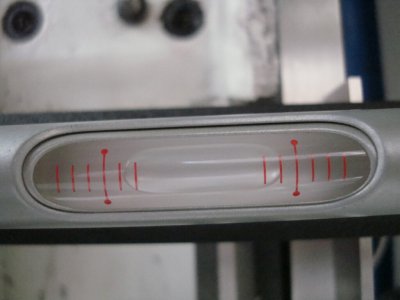
I then repeated the set up at the tail end.
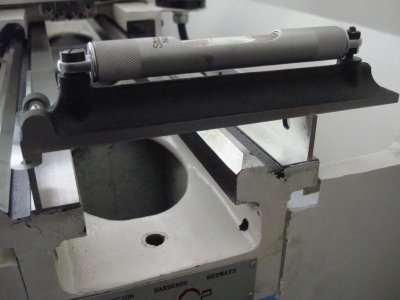
I had to add a feeler gauge leaf of 0.004" to get this reading.
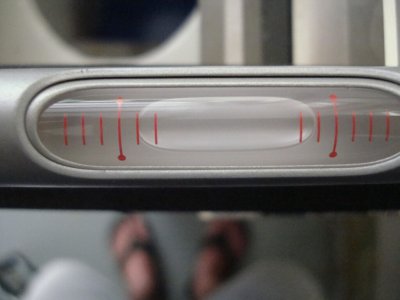
At first, I attempted to adjust the leveling feet to correct this error...the problem is, the base of the lathe is made from 3/16" thick 2x2 square, and the lathe is not heavy enough to flex it. I can adjust one of the tailstock end's leveling feet enough that the other one (rear) will come off the ground and the bubble will not move.
So in order to get the twist out, I am guessing I am going to have to shim it? If so, where would I put the shims? Under the base or under the tailstock foot?
When I put the thing together, I did the recommended smearing of silicone around the holes between the chip pan, the base, and the lathe's tailstock foot. I tightened everything down good, but I am wondering if that will cause any problems with the alignment.
What do you yall think I should do, or do I need to do anything with that amount of error over the whole length of the bed?
Thanks for any advice yall can offer!
Morgan







My first attempt wasn't the best but it was a start:

I came back inside, read a few things, changed speeds, and used a tool with a bit of a radius and did this:

Definitely better. I have some stainless bars that I scrounged, so I decided to give it a try to see whats what:

That one came out pretty nice! I must have gotten lucky :thinking:.
I have to say, watching that chip come off that stainless and across the face of the tool like a little stream of water was pretty cool.
I have a few questions about the setting up of this thing, I wanted to run past yall.
I have an actual project that I want to do, so I decided quit just playing around and set this thing up the way it is supposed to be to make it accurate. I have read a bunch of the leveling threads, and plan on doing the 2 collar method.
First, I decided to try to get as much twist out of the bed as I could with my level. I am guessing that this is the right way to set this up. I do understand why it does not need to be Earth level, but I am going by that as an easy to see standard.
I used a Starrett 98-8 level, 2 parallels (checked with a micrometer to make sure they were accurate), and used the flats of the ways. I cleaned all surfaces with napthalene, and when I changed to the tail end of the bed, I put the parallels in the same position relative to each other that I had used at the headstock end. Also, I made sure the parallels only sat on the ground surfaces of the ways. I seem to remember reading that the machinist levels have a slight bow in them, hence they way I placed it on the parallels. Here is what I did:

and this was the reading:

I then repeated the set up at the tail end.

I had to add a feeler gauge leaf of 0.004" to get this reading.

At first, I attempted to adjust the leveling feet to correct this error...the problem is, the base of the lathe is made from 3/16" thick 2x2 square, and the lathe is not heavy enough to flex it. I can adjust one of the tailstock end's leveling feet enough that the other one (rear) will come off the ground and the bubble will not move.
So in order to get the twist out, I am guessing I am going to have to shim it? If so, where would I put the shims? Under the base or under the tailstock foot?
When I put the thing together, I did the recommended smearing of silicone around the holes between the chip pan, the base, and the lathe's tailstock foot. I tightened everything down good, but I am wondering if that will cause any problems with the alignment.
What do you yall think I should do, or do I need to do anything with that amount of error over the whole length of the bed?
Thanks for any advice yall can offer!
Morgan








